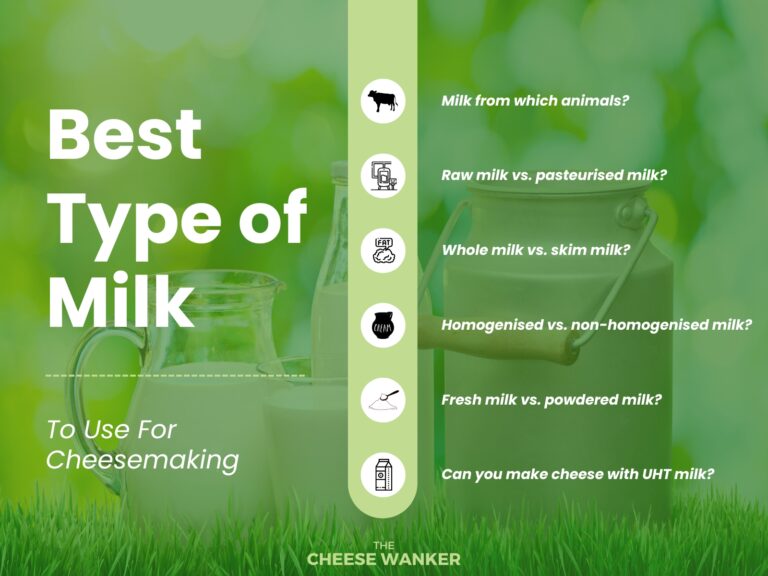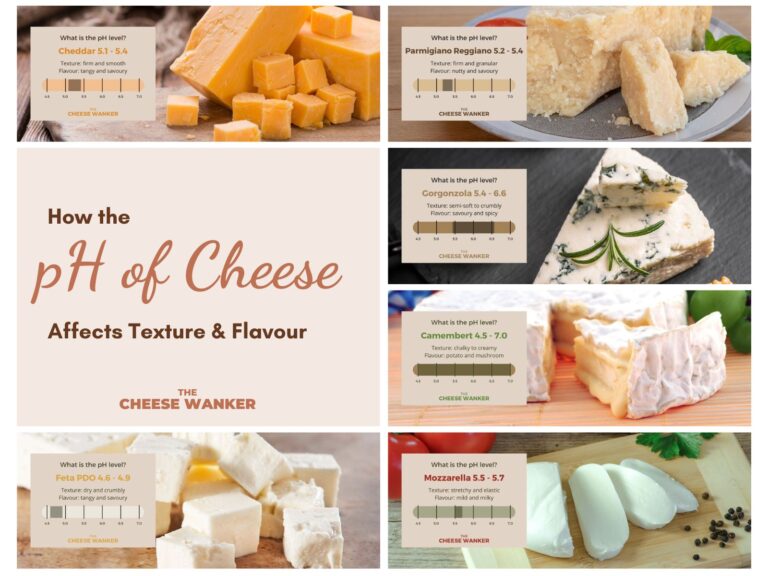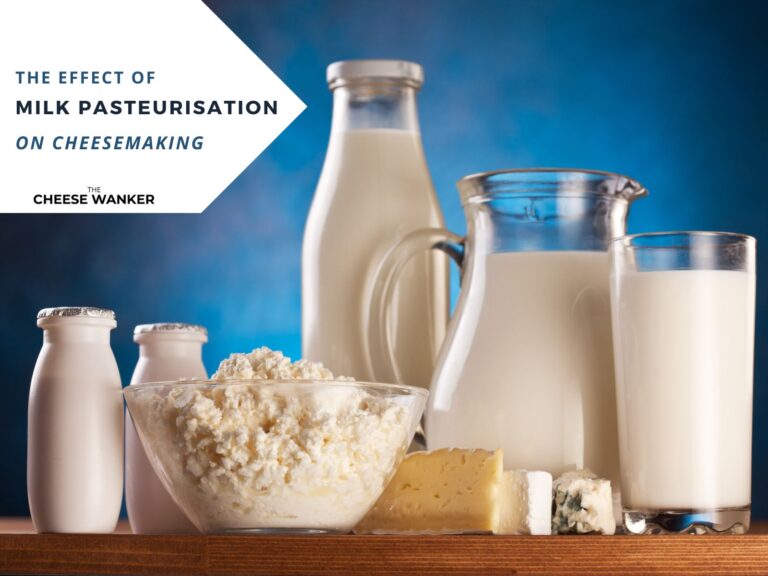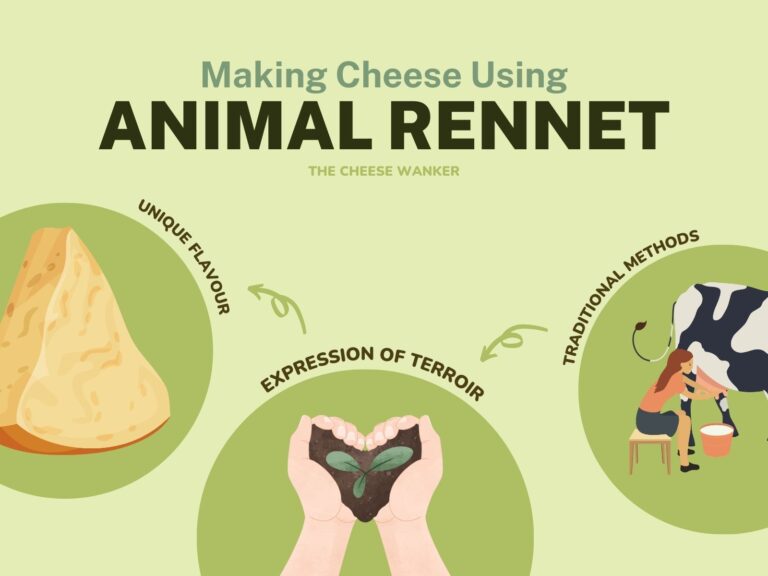Plant-based rennet is an alternative source of the enzymes used in cheesemaking, typically derived from plants like Cardoon Thistle, Fig, or Caper leaves. They are becoming more popular as a vegetarian alternative to traditional animal-derived rennet. Read on to learn more about their importance, and find out which plants can give you vegetarian-friendly rennet.
SEE ALSO: Our complete guide to rennet in cheesemaking →
What is rennet?
Let’s get this under way with some basics about rennet. To make cheese, you need to coagulate milk. And the ingredient most commonly used to coagulate milk is rennet. Traditionally, cheesemakers would use an enzyme called chymosin as their rennet.
As for the actual word itself, rennet is believed to be derived from the Old English word rynet, which means “cause to run together”. This is most probably a reference to how it makes milk run or curdle. Furthermore, chymosin is also known as rennin due to its use as rennet.
Nowadays, the most common types of rennet used to make cheese are animal, plant-based and microbial. You can read more about microbial rennet in our comprehensive guide here.
Animal rennet: an ethical dilemma
The use of animal-derived rennet in cheesemaking has raised ethical concerns due to the potential mistreatment of animals involved in its production. Animal rennet is typically obtained from the stomachs of young mammals, such as calves or lambs. And some animal rights advocates argue that the practices used to obtain the rennet can be cruel and inhumane.
Moreover, there is also the issue of overconsumption of animal-derived products, leading to the depletion of natural resources, environmental degradation, and the overuse of land and water for animal agriculture.
Some argue that the production of animal rennet contributes to the environmental impact of animal agriculture, including deforestation, greenhouse gas emissions, and water pollution.
In response to these ethical concerns, many cheesemakers have started to use alternative sources of rennet, such as microbial or plant-based rennet. These alternatives are considered more sustainable and ethical, as they do not rely on animal products and do not contribute to the environmental impact of animal agriculture.
You can read more about the ethics of animal rennet and what is being done to make it more sustainable by clicking here.
Advantages of using plant-based rennet
Plant-based rennet has several advantages over animal rennet, including the following. Firstly, plant-based rennet is suitable for vegetarians and those who avoid animal-derived products and genetically modified organisms (GMOs).
Furthermore, this type of coagulant is often made from sustainable plant sources and does not require the use of animal products.
The plants that we can extract rennet from are widely available. And their farming is less cost-intensive than animal farming and the lab methods used to extract microbial rennet. As a result, plant-based rennet tends to be less expensive than alternative forms.
Considerations when using plant-based rennet
When using plant rennet in cheesemaking, it is important to note that it may produce a slightly different flavour profile compared to animal-derived rennet. Also, thistle rennet can result in a softer curd compared to animal-derived rennet, which may affect the texture and quality of the final cheese product.
However, many cheesemakers prefer the unique flavour profile and texture produced by vegetable rennet, and consider it a high-quality alternative to traditional rennet.
It’s also important to note that certain plant-based rennet can be challenging to source in many countries. Cheesemakers who wish to use such rennet may need to special order it from a supplier. Additionally, it is important to ensure that the plant used to make the rennet is sourced from sustainable and ethically managed crops.
Types of plant-based rennet
Plant-based rennet is a type of rennet made from plants that produce chymosin-like enzymes. There are several types of plants that can be used to produce rennet, including:
1. Cardoon Thistle
Cardoon Thistle, also known as the Artichoke Thistle, is a species of thistle in the sunflower family. It is native to the Mediterranean region but is widely cultivated in other parts of the world as a food crop and an ornamental plant. Cardoon Thistle is a large, perennial plant that can grow up to six feet tall, with large, deeply lobed leaves and large, purple, thistle-like flowers.
The rennet-like enzymes found in Cardoon Thistle are produced in the plant’s flower. To extract the rennet, the flower is harvested, chopped, and soaked in water to release the enzymes. The solution is then strained and concentrated. The resulting solution is purified to remove any impurities and is then formulated into a rennet solution or powder that can be used for cheesemaking.
Cheesemakers in some parts of Spain (e.g., Extremadura) favour using Cardoon Thistle rennet in their cheeses. Unsurprisingly, the most popular milks used in those areas are often goat and sheep. And thistle rennet works best with those milks.
2. Nettle
Nettle (Urtica dioica) is a genus of herbaceous plants in the nettle family, native to many regions of the world, including Europe, Asia, and North America. The plant is known for its stinging hairs, but the young shoots and leaves of the plant can be used to produce a rennet-like enzyme for cheesemaking.
The process for producing Nettle rennet is similar to that for other plant-based rennet. Since the enzymes are found in the young shoots and leaves, you will start by harvesting those plant parts. To release the enzymes, you will need to soak them in water and strain the solution produced.
Finally, you concentrate and purify this solution before formulating it into a liquid or dry rennet form.
3. Fig
The Fig tree (Ficus carica) is a deciduous tree or shrub that is native to the Mediterranean region and western Asia, but is now widely cultivated throughout the world.
Fig trees are known for their sweet, juicy fruit, which is used in a variety of food and beverage applications, including fresh eating, cooking, and preserving. Besides, the Fig tree produces a latex-like substance, known as fig juice, that contains rennet-like enzymes.
To extract the rennet from fig trees, you start by harvesting the juice and concentrating it. This is typically done by straining the juice, boiling it, and then skimming off the solid residue that forms. Finally, in a similar manner to the first two plants we’ve mentioned, you purify the liquid and formulate it into a rennet solution or powder.
4. Dried Caper Leaf
Next, we have the caper plant (Capparis spinosa). This shrub is native to the Mediterranean region and parts of Asia. And it is best known for its edible flower buds, which are harvested before they bloom and are used as a flavourful ingredient in a variety of dishes, especially in Mediterranean and Middle Eastern cuisine.
The process for producing caper leaf rennet is similar to that for other plant-based rennet. Firstly, you need to crush the dried leaves of the caper plant and soak them in water. As a result, the leaves release a chymosin-like enzyme into the solution which you can strain and concentrate.
Once again, you complete the process by purifying the mixture and formulate it into a usable form for cheesemaking.
5. Ashwagandha
Ashwagandha (Withania somnifera) is a plant native to India and North Africa that has been used for thousands of years in traditional Ayurvedic medicine. For generations, locals have used the root and berry of this plant for medicinal purposes. Moreover, the root of Ashwagandha produces a rennet-like enzyme which can be used in cheesemaking.
To produce Ashwagandha rennet, the roots of the plant are harvested, dried and ground into a powder. Next, you will have to mix this powder with water to release the enzymes. Then, as always, you will strain, concentrate and purify the liquid.
Finally, you can use this pure liquid rennet as is to make cheese or you can dehydrate it into powder form.
6. Galium
Galium, also known as bedstraw or cleavers, is a genus of annual and perennial herbs in the Rubiaceae family. The plants are characterized by their small white or yellow flowers and their slender, whorled leaves. Overall, there are more than 400 species of Galium found throughout the world. And many of them have been used for medicinal purposes for centuries.
The process for producing bedstraw rennet is similar to that for other plant-based rennet. The dried leaves or stems of the bedstraw plant are crushed and soaked in water to release the enzymes. And you concentrate and purify the solution before formulating it into a usable form.
7. Ground Ivy
Our final example of plants producing rennet is Ground Ivy (Glechoma hederacea). Also known as Creeping Charlie or Gill-over-the-Ground, this is a species of perennial herb in the mint family. It is native to Europe and Asia and is widely distributed in temperate regions throughout the world.
Ground Ivy is known for its distinctive, scalloped leaves and its small, blue-violet flowers, which bloom in the spring and early summer.
The process for producing Ground Ivy rennet is similar to that for other plant-based rennet. Firstly, you harvest its leaves before drying, crushing and soaking them in water. This releases the chymosin-like enzymes into a liquid medium which is strained and concentrated. As always, the final step is to formulate the concentrated solution into a form that can be used to make cheese.
Examples of cheeses made using plant-based rennet
There are some amazing traditional and modern cheeses made around the world using plant-based rennet. And the most amazing part is that they are made this way because it produces the best quality cheese using local ingredients. Let’s have a look at three of the best.
Want to see more vegetarian cheeses? Click here for our best 13 cheeses!
Torta del Casar
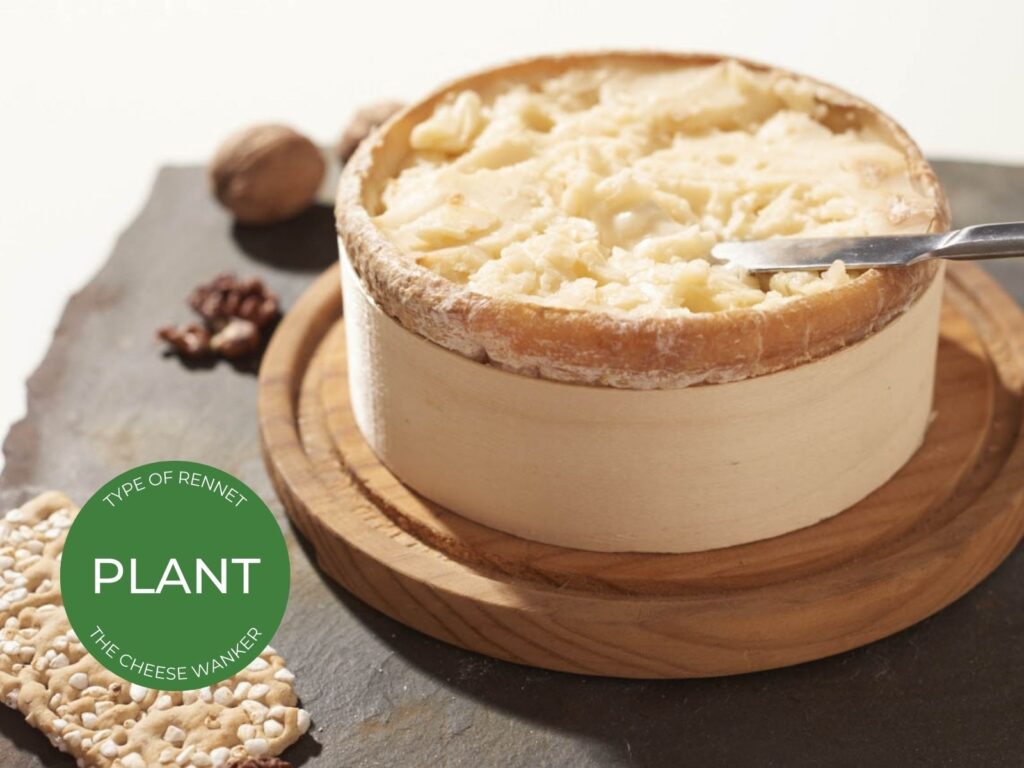
Without a doubt, Torta del Casar is one of Spain’s most popular soft cheeses. According to Spanish legends, shepherds who originally made this sheep’s milk cheese realised that its interior would be almost liquid when the cheese ripens. As a result, the middle of the cheese would sink. Hence, the shepherds used the word atortado (meaning cake-shaped) when referring to this particular cheese. Since it is made using cardoon thistle, Torta del Casar is a vegetarian friendly-cheese.
With a light and thin semi-hard rind, the cheese’s main feature is its decadently creamy texture. At optimal ripeness, the insides of Torta del Casar have been known to pour out from any crack in the rind. With its characteristic aroma and intense and well-developed taste, this wonderful sheep’s milk cheese will melt in your mouth. The more refined palates among you might detect the slightest touch of bitterness that is imparted by the Cardoon Thistle.
The best way to enjoy this decadent cheese is to bring it to room temperature, and use a sharp knife to open the top of the rind. Then, you can spread the oozy insides on fresh or lightly toasted bread.
Azeitão
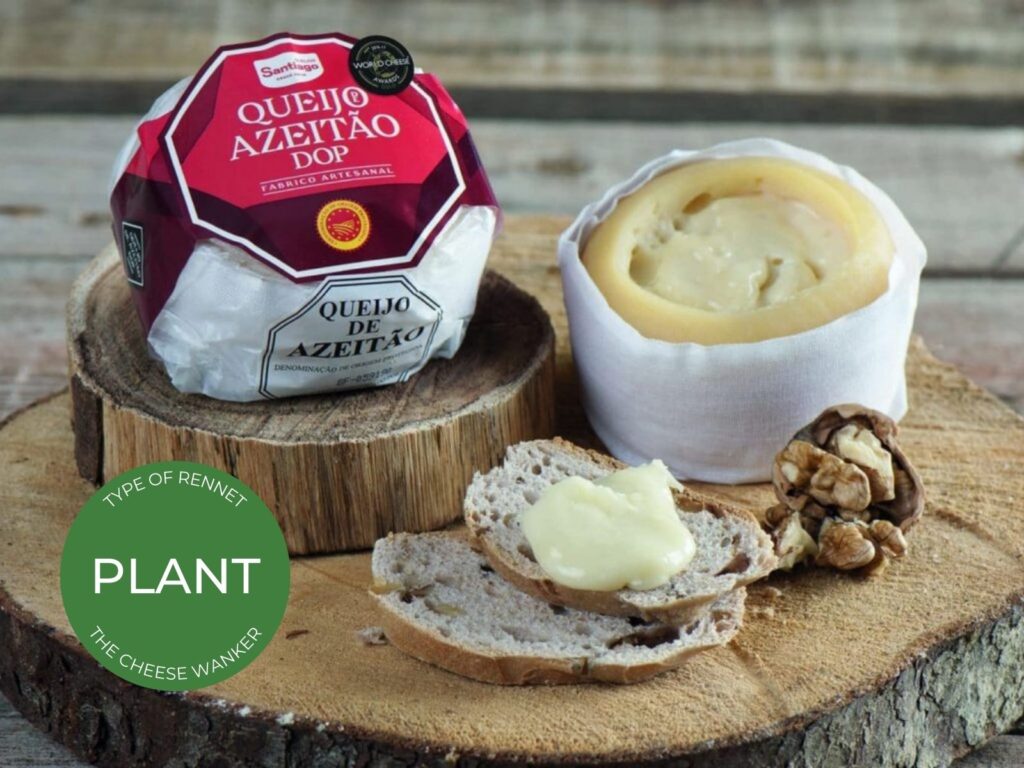
Next, we have another soft sheep’s milk cheese. Indeed, Azeitão is a soft raw milk cheese that is made by select farmhouse dairies in the Arrábida Mountains of southern Portugal. Local cheesemakers coagulate the milk using a vegetable rennet that is derived from the stamens of the Cardoon Thistle flower.
Azeitão’s texture is smooth and velvety when ripe, becoming harder and drier as the cheese ages. Its rind is a rust-brown colour, and is occasionally dotted with patches of white mould. The interior paste is ivory-white and oozes at room temperature. Finally, the cheese’s aroma can be fairly pungent and sheepy. Because of the Cardoon Thistle rennet, Azeitão tends to develop a slightly sour taste with a touch of bitterness. Overall, this balances well the sweetness of the sheep’s milk and the herbaceous and vegetal notes in the cheese.
Due to Azeitão’s robust flavour and aroma, it is best paired with more moderate flavours. Sweet white wines from the same region or medium-bodied red wines with low tannin levels will work wonders.
Cashel Blue
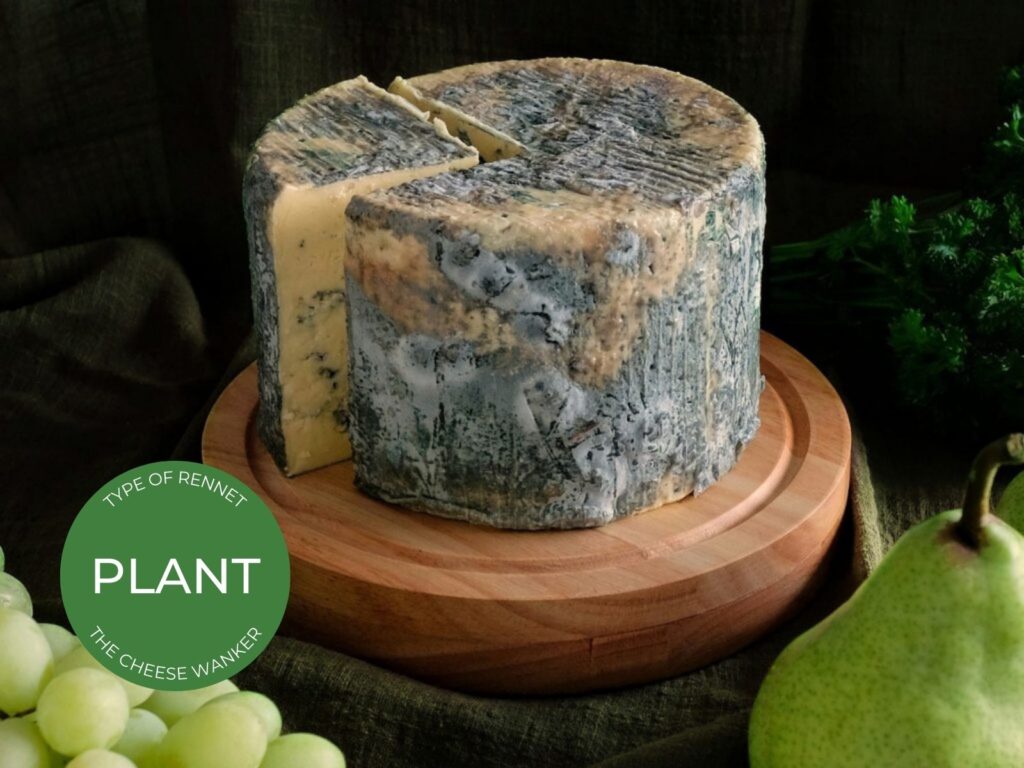
Our final cheese on the list is Ireland’s Cashel Blue. Cashel Blue is a cow’s milk blue cheese made by Cashel Farmhouse Cheesemakers in County Tipperary, Ireland. It was the first cheese that Jane & Louis Grubb made when they established the artisanal dairy in 1984.
Actually, the name of the cheese comes from the Rock of Cashel. And legend has it that it was here that Saint Patrick began the conversion of the Irish to Christianity.
Made with pasteurised cow’s milk and thistle rennet, the wheels of cheese are then matured for up to six months. At two months, the cheese is firm and creamy near the edge with a subtle tanginess. However, it truly comes into its own at three months when its texture breaks down and its flavour is richer and fuller with a touch of spice. Its paste is buttery yellow and the blue mould appears as marbling throughout and also on the rind.
Enjoy this stellar Irish blue with green grapes and pears. And you can wash it all down with a fresh IPA or a glass of Chimay.
Plant-based rennet FAQ
Let’s finish up our guide to plant-based rennet with some of your most commonly asked questions.
How do I know if my cheese was made with plant rennet?
Unfortunately, food authorities around the world do not require cheesemakers to identify the rennet they use on their product labels. Having said that, most producers using vegetable or microbial rennet will often highlight that on their products. If you are unsure whether a particular cheese is vegetarian-friendly, we recommend contacting the manufacturer to find out.
Is vegetable rennet same as plant-based rennet?
The short answer here is no. Unfortunately, many companies also label microbial rennet and Fermentation Produced Chymosin (FPC) as vegetable rennet. The latter can be derived from animal RNA and may not be suitable for some traditional vegetarians.
Can I make my own plant-based rennet?
Technically, yes you can. But we wouldn’t recommend it because the concentrating and purification steps can be quite challenging. And you could potentially waste a lot of milk if your rennet does not perform.
How much plant-based rennet do I need to use?
There are multiple brands of vegetable rennet available and each one will have different concentrations of enzymes. Hence, it is critical that you follow the manufacturer’s instructions for use.
Conclusion: plant-based rennet is ethical and sustainable
Thank you for reading our post on plant-based rennet. As you can see, there are a large number of plants that produce chymosin-like enzymes. While Cardoon Thistle is the most popular in Europe, you will definitely find cheeses around the world made using rennet from the other plants.
Have you tried making your own cheese using plant rennet? We would love to hear from you in the comments.
